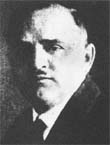

Emil Králíček
*11. 10. 1877 – Havlíčkův Brod, Czech Republic
†1930 – Prague, Czech Republic
The architect Emil Králíček was originally known only to a few theorists. He worked, as was customary at the turn of the past centuries, anonymously in the large construction firm of Matěj Blechy. Králíček's work went through various stages, but its character was always clearly distinguishable from that of his contemporaries. Some of his works were originally attributed to other authors, such as the lantern in Jungmann Square to Vlastislav Hofman, while others were unknown even to the professional public. Králíček's handwriting is relatively distinctly readable, and thus, through thorough research, it was possible to prove his authorship for many of Prague's Art Nouveau and Cubist buildings or at least their facades.
Králíček was born in Havlíčkův Brod, studied at a gymnasium and a specialized industrial school, and completed an internship with architect Balšánek. In the second half of the 1890s, he moved to Darmstadt, where he joined the studio of Josef Maria Olbrich, which was addressing current architectural tasks. In 1903, he returned to Prague and joined the renowned Blech firm's staff, which was acquiring a number of orders in the then rapidly expanding core of Prague.
During World War I, Králíček was called into military service, and after 1922, when he returned to Prague, we find traces of his activity in the implementations of his firm Králíček – Šolc. In 1930, he committed suicide. The reasons could have been family disputes, as well as economic difficulties.
Králíček was born in Havlíčkův Brod, studied at a gymnasium and a specialized industrial school, and completed an internship with architect Balšánek. In the second half of the 1890s, he moved to Darmstadt, where he joined the studio of Josef Maria Olbrich, which was addressing current architectural tasks. In 1903, he returned to Prague and joined the renowned Blech firm's staff, which was acquiring a number of orders in the then rapidly expanding core of Prague.
During World War I, Králíček was called into military service, and after 1922, when he returned to Prague, we find traces of his activity in the implementations of his firm Králíček – Šolc. In 1930, he committed suicide. The reasons could have been family disputes, as well as economic difficulties.
The English translation is powered by AI tool. Switch to Czech to view the original text source.
Realizations and projects
Realizations and Projects
Benies Villa, Lysá nad Labem, 1912-131 comment
add comment
Subject
Author
Date
fotodokumentace přestavby objektu Karlových Lázní z r. 1924
Anna Šolcová
27.03.09 11:10
show all comments










